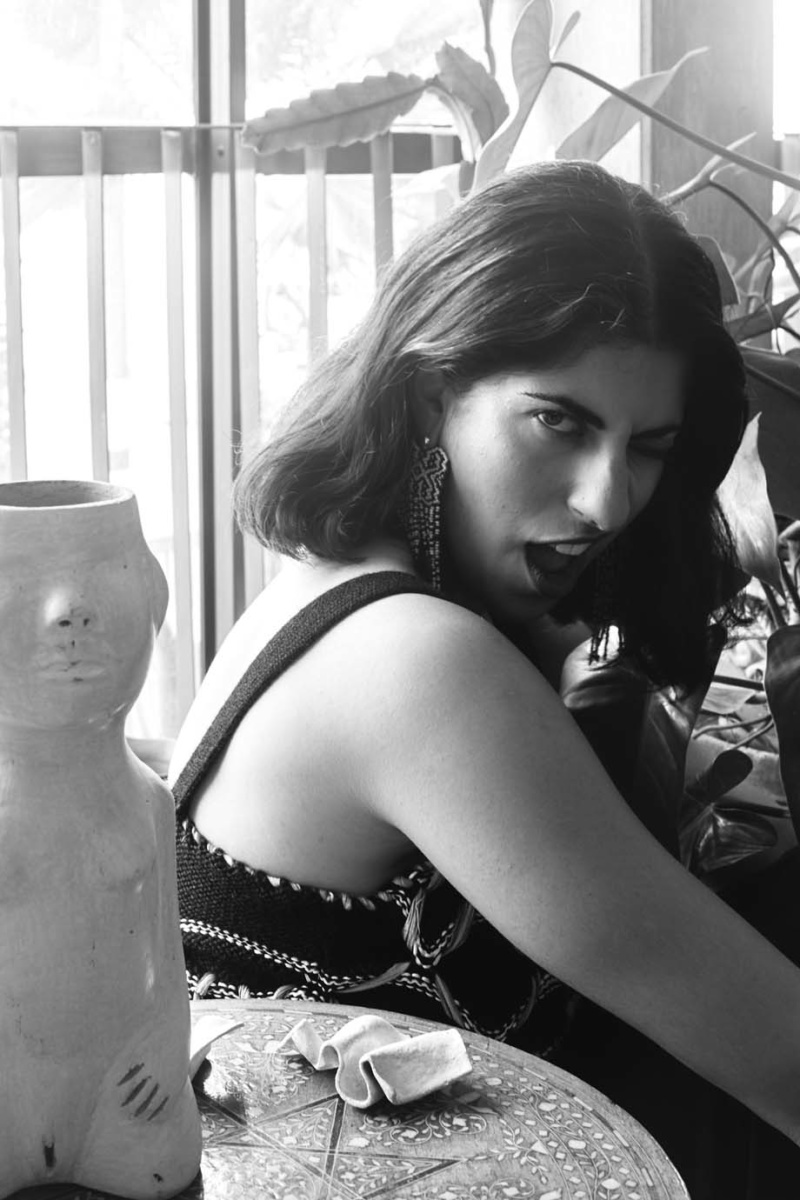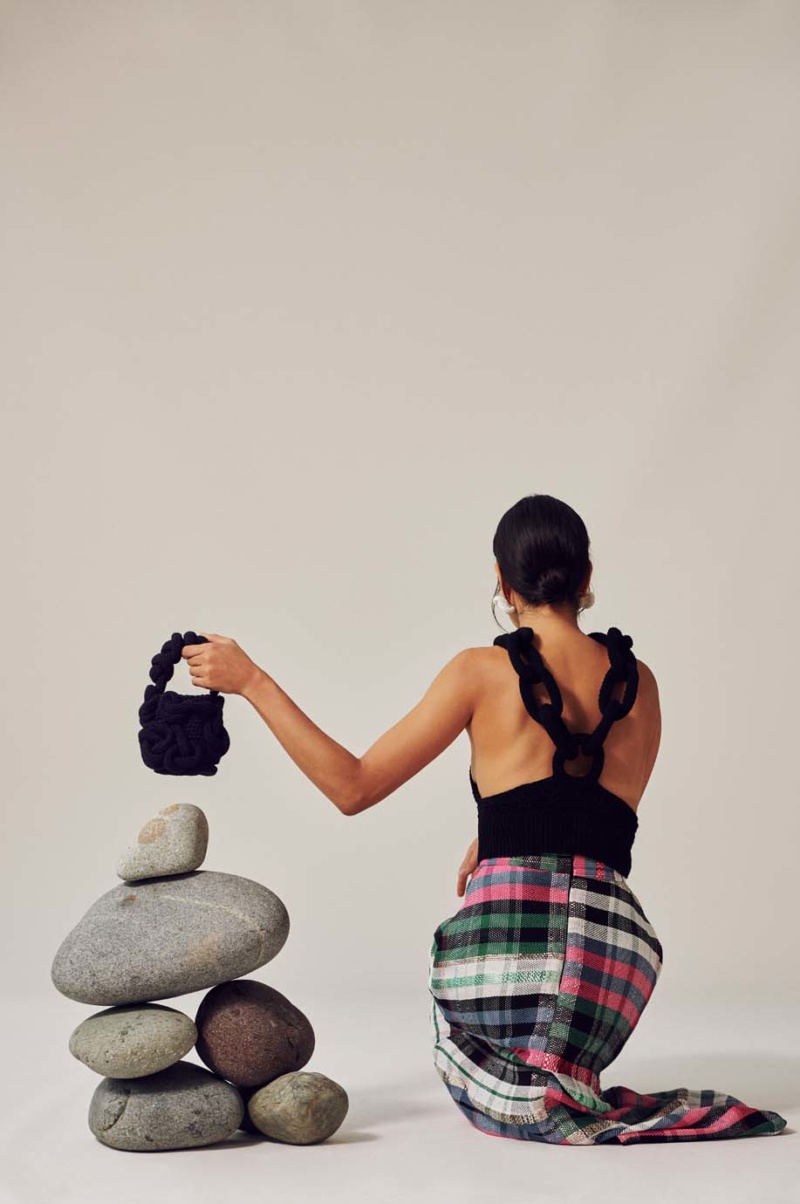
Mozhdeh Matin and I are Skyping on a Tuesday afternoon. I’m at my desk in a corner of Upstate New York; she’s situated on a bustling street in Lima. As we speak, I hear birds chirping in the background, cars driving by, the barking of dogs. An image forms in my mind of Matin, surrounded by the noise and clatter of life and its vibrant energy. I’m so engrossed by her descriptions of the history of textiles in her native Peru that I forget that I’m conducting an interview with a fashion designer and feel rather more like an eager pupil soaking up stories of an illustrious past.
“For the Incas, textiles were always the place where you wrote your story and what it represents. Your community, your family, your heritage. It was sacred. It was like writing.” The Incan civilization valued its textiles so much more than its gold that its leaders purportedly offered the latter to the Spanish invaders with little hesitation, in order to protect the textiles. “[Textiles] were so precious to the Incas,” she tells me, “that they even burned some,” rather than give up the stories of their heritage to the conquistadors.
“That’s the opposite of how we value textiles today,” I remark. She sighs in response, and I sense that I’ve perhaps hit a sore spot. “It’s such a struggle,” she says, “it’s still weird for me. I’m trying to figure it out.” This is probably the first time I’ve ever heard a designer lament the valuation of clothing as anything other than a commercial product.
She’s quick to note that, at the end of the day, yes, she’s running a business. But her reasons for founding her brand Mozh Mozh in 2015 are atypical. Matin was born in the Peruvian Andes to Iranian parents and she credits her early interest in fabrics, patterns and prints to growing up immersed in two cultures known for their ancient textile heritages. She laughs as she tells me that as a child she was always touching things to feel their texture. Her curiosity led her to travel throughout Peru, discovering a variety of extraordinary textiles and tracing each one back to the community that created it. From these artists, she learned not only their technique but also what the textiles meant to each of them.
Her collections today are the result of ongoing, in-person creative exchanges between designer and manufacturer. “I never show them something and say, ‘do exactly this.’ I always try to find a balance that I hope both of us will be fine with. It’s more like, ‘oh, I love what you’re doing, what if we do it with these colors?’” She recently collaborated with workers in the Amazon called shiringueros who produce natural rubber from the shiringa tree. The resulting material is a plant-based latex that is applied to natural cotton, creating a locally-sourced and sustainable alternative to animal leather.

Her collections are the result of a joint decision-making process between designer and manufacturer, one in which the latter maintains a large degree of creative license. This in-the-flesh exchange creates a social structure that stands in stark contrast to the majority of designer-manufacturer relationships today, which tend to be characterized by their social, symbolic and physical distance. It’s interesting to consider that a closer physical proximity between a designer and the person who is constructing her product might be an important factor in the reprioritization of social concerns over economic ones.
A concern she cites during our conversation is that many of the textile techniques featured in her garments are at risk of disappearing as younger generations of the rural communities that produce them move to the cities to pursue more modern occupations. Mozh Mozh is a vehicle for preserving these techniques, at least for a while. The brand also serves as a means of providing women, who make up 90% of her workforce, with an income, granting them financial independence within their family structure.
I first came across Matin’s garments at her press showroom in New York City. A rack was packed with chunky knitwear tops and woven dresses in a variety of textures and patterns that I’d never seen before. In contrast to the neutral tones that pervaded the other collections in the showroom, her color palette stood out as bright and inviting. I couldn’t help running my fingers over the garments, scrunching a red and brown knit dress in my hands so that it bunched up into a satisfying thickness. The garments were individual, different: they were relevant to the zeitgeist yet unconcerned with its trends. As I admired the cocktail-length frock, I had a distinct impression that I hadn’t felt in a while: this was a timeless piece.

With Mozh Mozh, there’s an implicit understanding that the garment is more than just a disposable product. This is markedly different from the majority of clothing production today, fast fashion and luxury alike. “I think the biggest problem comes from consumerism, from the fact that people are convinced by big brands that they need to buy more,” Matin explains. The problem is also that, even in the luxury sector where consumers can ostensibly afford to choose ethically designed and produced items, buyers often don’t take into consideration where their clothes come from. For the most part, Matin says, “all that matters is the name of a brand, or if it’s trendy.”
I ask Matin what she thinks about the Carolina Herrera Resort 2020 collection, which drew the ire of the media and even a member of the Mexican government when the brand debuted dresses and separates that featured exact replicas of Indigenous embroideries and textiles. In addition to the timeless ethical problem of a luxury brand (which, by definition, caters to the wealthy) profiting off the creative ideas of a voiceless community, Matin also brings up an interesting technical point: “If you’re a designer or a creator, you’re a curious person. You’re trying to see things and translate them into design. So I feel like when you’re appropriating something from a culture, you’re not doing your work right. You’re just taking the first thing you see—the most obvious—and you’re not going any deeper than that. You need to do more to investigate.” She says that, from a design standpoint, basically, “you’re being lazy.”

That fashion has always involved a degree of directly knocking off other designs is as true now as it ever was; this happens in nearly every creative discipline. It’s also worth noting that the creative process has always walked the fine line between influence and plagiarism. The problem isn’t about where an artist’s inspiration comes from: it’s about how that inspiration is treated along the way. As Matin puts it, “it’s all about respect,” and taking the time to understand. Ethical problems occur when a brand commandeers an aesthetic from a culture and consequently reinforces a stereotype, or (in the case of the Herrera collection) when the designs created by a disenfranchised community are exploited by companies worth billions of dollars.
It’s also important to make a distinction between fashion designers and the directors of the conglomerates who own the majority of household name brands. For one thing, fashion designers have far less power than the public generally realizes. The real culprits are the CEOs of the major fashion conglomerates; designers— even the famous ones—are often treated like pawns in a huge, unintelligible game of chess.
Matin believes that ultimately, respect lies in taking more time to understand the meaning behind an aesthetic. “If you have a fashion brand that makes many, many collections a year, and you’re always trying to make something new, you don’t have time to investigate.” This explanation may sound reductive, but it’s not: most designers are not given enough time to design a collection. Like all corporate industries today, fashion is run by the big-business mentality of growth-at- all-costs, with little if any consideration of the ethical consequences.

Beginning around 2007, the fashion retail cycle increased from two collections a year (Fall and Spring), to about a dozen (Fall, Spring, Resort, Pre-Fall, Fall Couture, Spring Couture, Mens Fall, Mens Spring, Bridal Fall, Bridal Spring, to name just a few). The pressure on designers to produce has become, according to many, unsustainable. Former British Vogue fashion director Lucinda Chambers wrote in her provocative interview for Vestoj magazine that: “Businessmen are trying to get their creatives to behave in a businesslike way; everyone wants more and more, faster and faster…The designers do it, but they do it badly…”
One of the main reasons for the increase in annual collections is the luxury sector’s response to the rise of fast-fashion retailers, who copy designs from the runway and sell them faster than luxury brands are able to. This vicious cycle has led not only to increased design oversight, but also to massive environmental devastation and innumerable counts of human exploitation that often amount to slave labor.

Smaller brands that have come of age with an awareness of these problems have the unique advantage of adopting more mindful practices with greater ease, since they do not bear the burden of corporate pressure. That said, how does one participate in the fashion system without falling prey to its more nefarious attributes? “I feel like I have one foot in the door, and one foot outside the door. I participate in market week, because in the end this is a business, but I also have this feeling that this is not the only way, and that we need to find other ways. I am looking because I don’t feel good being part of the system.” I ask her if she has any ideas in mind. “I usually do two collections a year, but I’ve actually been thinking about whether I should just do one instead.”
It struck me how Matin’s recounting of the Incan civilization’s estimation of textiles was echoed in her own estimation of clothing. Placing greater creative, emotional and social value on clothing design and manufacturing provides a model that could help designers—and, indeed, creatives of all fields—navigate the creative process in a way that positively engages everyone involved. No doubt her situation is uniquely advantageous: she is based in a country known for its vibrant textile practices; she designs in close proximity to the artisans who produce her collections, thus fostering an economic model that prioritizes the social connection with her manufacturers; and, Mozh Mozh is small enough that she doesn’t have to face the economic concerns that larger independent brands do. Nonetheless, this brand is exemplary, and with hope, will prove to be a sign of things to come.










 in your life?
in your life?

